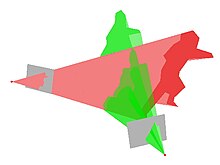Visual hull
This article has multiple issues. Please help improve it or discuss these issues on the talk page. (Learn how and when to remove these messages)
|


A visual hull is a geometric entity created by shape-from-silhouette 3D reconstruction technique introduced by A. Laurentini. This technique assumes the foreground object in an image can be separated from the background. Under this assumption, the original image can be thresholded into a foreground/background binary image, which we call a silhouette image. The foreground mask, known as a silhouette, is the 2D projection of the corresponding 3D foreground object. Along with the camera viewing parameters, the silhouette defines a back-projected generalized cone that contains the actual object. This cone is called a silhouette cone. The upper right thumbnail shows two such cones produced from two silhouette images taken from different viewpoints. The intersection of the two cones is called a visual hull,[1] which is a bounding geometry of the actual 3D object (see the bottom right thumbnail). When the reconstructed geometry is only used for rendering from a different viewpoint, the implicit reconstruction together with rendering can be done using graphics hardware.[2]
In two dimensions
[edit]This section needs expansion. You can help by adding to it. (December 2008) |
A technique used in some modern touchscreen devices employs cameras placed in the corners situated opposite infrared LEDs. The one-dimensional projection (shadow) of objects on the surface may be used to reconstruct the convex hull of the object.[citation needed]
Visual hull generation method has also been used within experimental tele-meeting systems[3] that aim to allow a user in a remote location to interact with virtual objects. The method uses multiple cameras to capture the real-world movements and interactions of the "sender", employing hardware-accelerated volumetric visual hull representation to create 3D volume from 2D multi-view images. Its ultimate aim is to allow 3D collaboration between the two users in the virtual realm, with the visual hull technique reducing the computational power required to allow this type of interaction and enabling the use of consumer goods such as the Wii Remote as a tool for interaction.
See also
[edit]References
[edit]- ^ A. Laurentini (February 1994). "The visual hull concept for silhouette-based image understanding". IEEE Transactions on Pattern Analysis and Machine Intelligence. 16 (2): 150–162. doi:10.1109/34.273735.
- ^ Li, Ming and Magnor, Marcus and Seidel, Hans-Peter (May 2003). "Hardware-Accelerated Visual Hull Reconstruction and Rendering" (PDF).
{{cite web}}: CS1 maint: multiple names: authors list (link) - ^ Hwang, Jane (September 2008). "Augmented robot agent: Enhancing co-presence of the remote participant". ResearchGate.


 French
French Deutsch
Deutsch